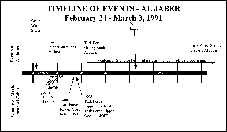
After Al Jaber was cleared of Iraqi forces by Task Force Grizzly on February 26th, the Marines began to ready the base as a forward base for Marine aircraft. Task Force Grizzly maintained the base and the perimeter until March 3rd (Figure 9). The commander of Task Force Grizzly set up his headquarters in a former air-to-air missile ammunition storage point. According to the commander, the Marines of Task Force Grizzly reported no signs of chemical weapons storage or chemical warfare symptoms from use.[75]
Figure 9. Timeline of Events, Feb. 24 - March 3, 1991.
In order to prepare the base for offensive actions, Marine Explosive Ordnance Disposal (EOD) teams were sent to the base to clear away hazardous weapons. The Marine Air Logistics Squadron 16 (MALS 16) EOD Team arrived at Al Jaber by helicopter early on February 26th. Their primary mission was to collect and destroy unexploded munitions on the runways. Most of the munitions they encountered were "area denial" mines and bomblets dropped on the base by Coalition aircraft during the air war or Kuwaiti Air Force munitions left from before the war. The EOD team also found Iraqi munitions. After inspecting and testing these munitions (with M-8 chemical detection paper[76] where appropriate), none were found to be chemical and all were subsequently destroyed.[77] Although the EOD team was concerned primarily with preparing the air base for operations, the commander stated that they were "ammunition curious" and looked into everything they could. The MALS 16 team left the air base on March 3rd.[78]
In addition to Task Force Grizzly and MALS 16, the 1st and 2nd EOD Platoons of the 7th Engineer Detachment performed cleanup operations on the base. They went through all storage areas looking for anything suspicious such as leaking munitions or weapons that might have chemical agent filler plugs. Most of the ammunition in these facilities was Kuwaiti Air Force ammunition of various manufacture. The 1st Platoon worked outside the base, while the 2nd Platoon cleared inside the base. The 2nd Platoon left the area on March 1st and the 1st Platoon then took over the base and cleared munitions found in the area through April. Neither the 1st nor the 2nd Platoons report finding any chemical weapons (persistent or non-persistent) or evidence of persistent chemical weapons use. Additionally, no one recalls finding any Iraqi 155mm shells—later confirmed as a the primary ground delivery system of Mustard weapons.[79] Some of the unit files were routinely destroyed on a two year cycle, so records of all destroyed munitions are not available.[80]
| First Page | Prev Page | Next Page |